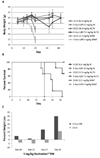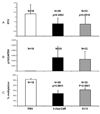S110, a 5-Aza-2'-deoxycytidine-containing dinucleotide, is an effective DNA methylation inhibitor in vivo and can reduce tumor growth
- PMID: 20442312
- PMCID: PMC2868087
- DOI: 10.1158/1535-7163.MCT-09-1048
S110, a 5-Aza-2'-deoxycytidine-containing dinucleotide, is an effective DNA methylation inhibitor in vivo and can reduce tumor growth
Abstract
Methylation of CpG islands in promoter regions is often associated with gene silencing and aberrant DNA methylation occurs in most cancers, leading to the silencing of some tumor suppressor genes. Reversal of this abnormal hypermethylation by DNA methylation inhibitors is effective in reactivating methylation-silenced tumor suppressor genes both in vitro and in vivo. Several DNA methylation inhibitors have been well studied; the most potent among them is 5-aza-2'-deoxycytidine (5-Aza-CdR), which can induce myelosuppression in patients. S110 is a dinucleotide consisting of 5-Aza-CdR followed by a deoxyguanosine, which we previously showed to be effective in vitro as a DNA methylation inhibitor while being less prone to deamination by cytidine deaminase, making it a promising alternative to 5-Aza-CdR. Here, we show that S110 is better tolerated than 5-Aza-CdR in mice and is as effective in vivo in inducing p16 expression, reducing DNA methylation at the p16 promoter region, and retarding tumor growth in human xenograft. We also show that S110 is effective by both i.p. and s.c. deliveries. S110 therefore is a promising new agent that acts similarly to 5-Aza-CdR and has better stability and less toxicity.
Figures





References
-
- Jones PA, Takai D. The role of DNA methylation in mammalian epigenetics. Science. 2001;293(5532):1068–1070. - PubMed
-
- Kaneda M, et al. Essential role for de novo DNA methyltransferase Dnmt3a in paternal and maternal imprinting. Nature. 2004;429(6994):900–903. - PubMed
-
- Bird A. DNA methylation patterns and epigenetic memory. Genes Dev. 2002;16(1):6–21. - PubMed
-
- Jones PA, Baylin SB. The fundamental role of epigenetic events in cancer. Nat Rev Genet. 2002;3(6):415–428. - PubMed
Publication types
MeSH terms
Substances
Grants and funding
LinkOut - more resources
Full Text Sources
Other Literature Sources

